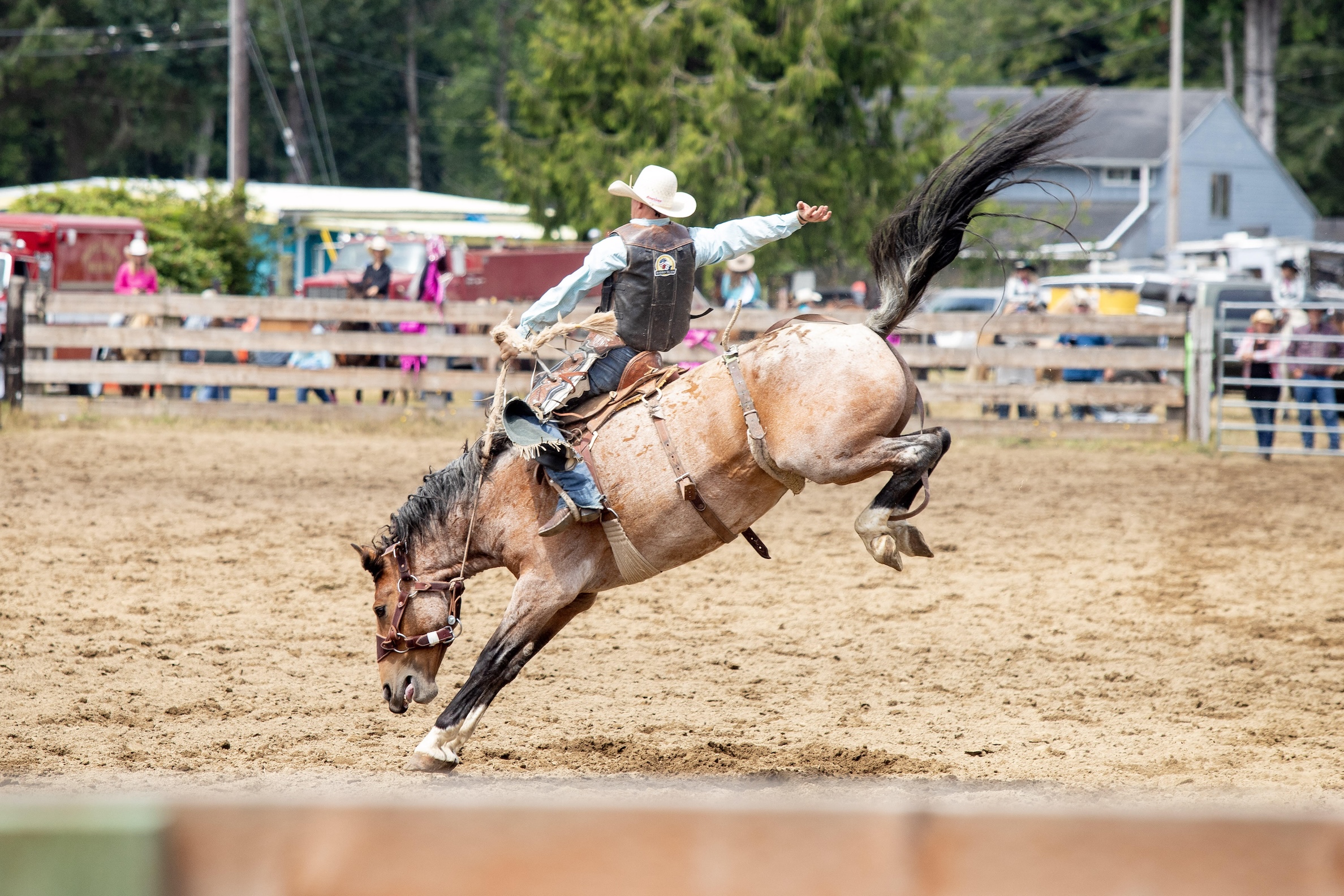Moving the needle on coastal accessibility
Published 9:00 am Friday, April 11, 2025
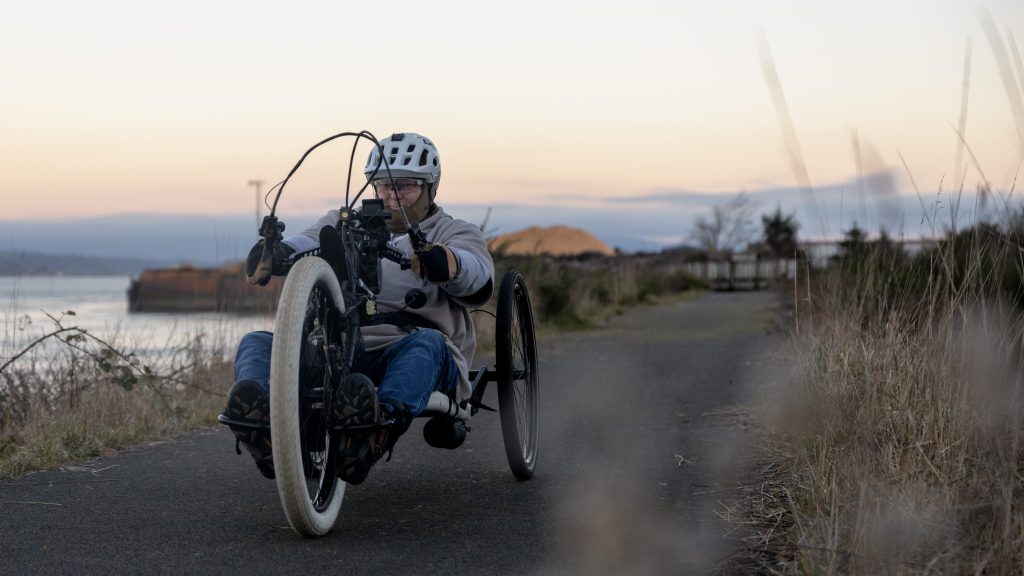
- Tom Sayre speeds along the Warrenton Waterfront Trail. With a handcycle, he can access a variety of terrain including grass and gravel. (Lukas Prinos/The Astorian)
For Tom Sayre, a typical bike route spans at least 20 miles.
On most rides, Sayre hits the pavement in his neighborhood before dropping down to Skipanon River Park to pick up the Warrenton Waterfront Trail. From there, he takes in sweeping views of the Columbia River, passing through Carruthers and Seafarers’ parks and onto the trails at Fort Stevens. Often, he’ll stop by the ocean before looping past Coffenbury Lake to return home.
In this corner of the North Oregon Coast, the rides are sometimes sunny, sometimes soggy, but always keep him coming back for more.
Trending
“I mean, where else can you ride 20 miles and ride through forests, along a big river, see the ocean, stop at a lake?” Sayre said. “I don’t know, that’s probably one of the best routes you could ask for.”
There’s more at play than picturesque views, though.

A handcycle is a type of bicycle powered by the rider’s arms. (Lukas Prinos/The Astorian)
Sayre broke his back decades ago, and has used a wheelchair ever since. It wasn’t until after college that he discovered handcycling, a sport where riders use their hands, rather than their feet, to pedal. These days, he gets out once or twice every week on a custom-made, three-wheeled handcycle.
Sayre has been advocating for increased accessibility in outdoor recreation for the past 35 years — and in some ways, that type of advocacy has paid off: a few dozen years ago, even an accessible outdoor restroom might have been hard to come by. Now, more and more ADA-compliant facilities and adaptive gear suppliers are dotting the map. But the work is far from complete.
According to the United States Census Bureau, around 15% of Oregonians have some type of disability, and around 7% have a mobility-related disability. Despite that, many still face barriers to accessing the trails, parks and beaches that draw swaths of visitors to the coast each year. Gradually, cities, agencies and individuals across the state are taking steps to move the needle.
Addressing barriers
When Sayre gets out on his handcycle, it’s an escape from the ordinary.
“It’s a rare occurrence that somebody that’s in a wheelchair, underneath their own speed, can go fast enough to feel the wind blow through their hair, their eyes water,” he said.
There’s a wealth of places nearby to make that escape, too — among his favorites, the Astoria Riverwalk, the Banks-Vernonia Trail, the Discovery Trail and the winding paths of Fort Stevens State Park. On slower days, when he feels like getting farther from the crowds, he might go with his family to the Willapa National Wildlife Refuge, Cedar Wetlands Preserve, Kilchis Point Reserve or Cascade Head Preserve.

A tug passes by along the Warrenton Waterfront Trail. (Lukas Prinos/The Astorian)
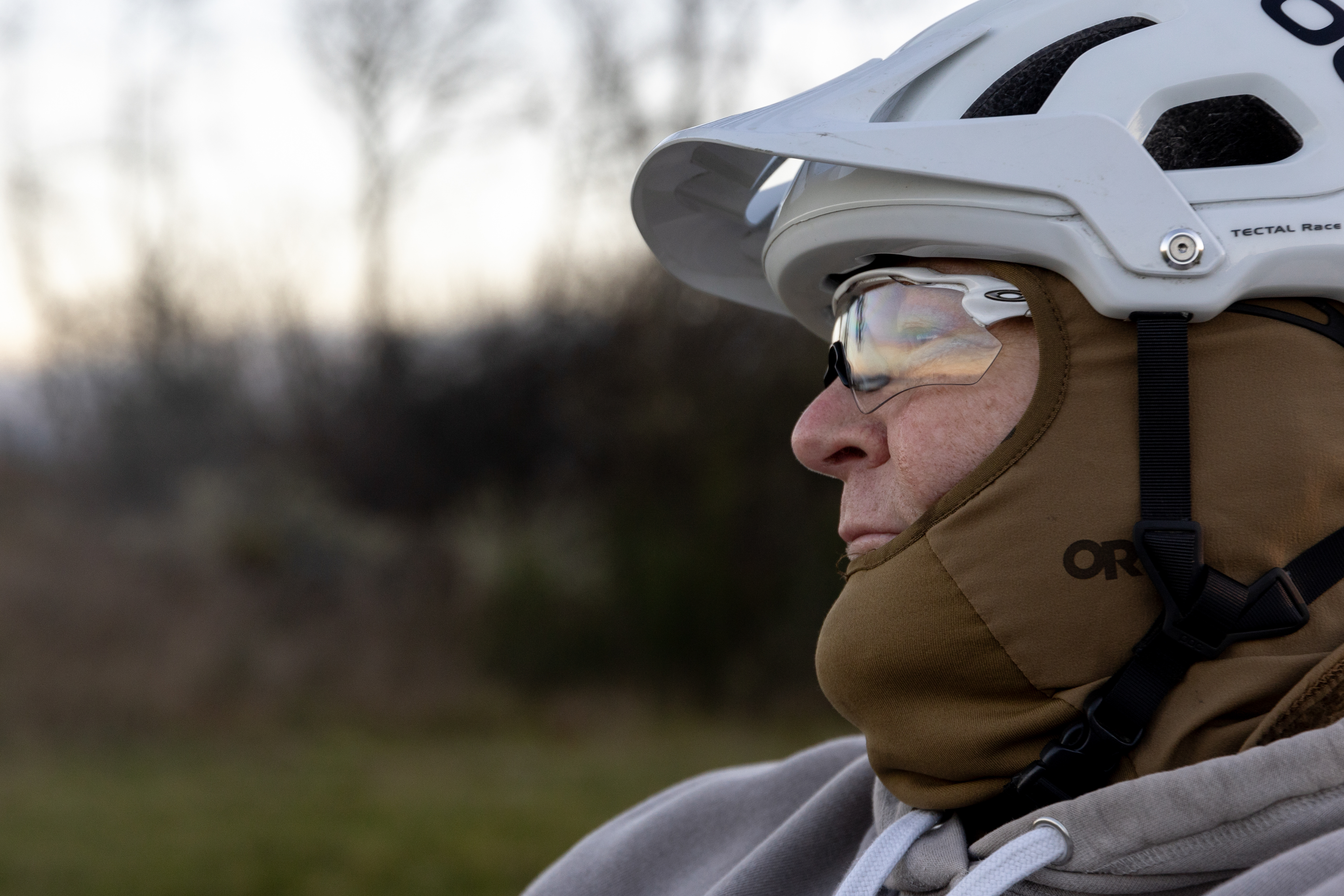
Tom Sayre gazes out over the Columbia River at sunset. (Lukas Prinos/The Astorian)
Still, there are other places Sayre can’t get to. On a recent ride, he pulled up to a trail off Perkins Road at the edge of Lewis and Clark National Historical Park. It’s one he might have kept going on, except for an obvious obstacle: a brown metal gate, stretching from one side of the entrance to the other.
Sayre calls this kind of physical barrier a showstopper — and for good reason. Although hikers and dog walkers can usually slip through the space between a gate and the edge of a trail, someone using a mobility device often can’t.
He doesn’t have to look far to find similar issues nearby.
Off an overlook along the Fort to Sea Trail, a set of boulders stand as an impassable barrier. In Warrenton, gates cut off access to much of the Airport Dike Trail. Sayre said he can name plenty of other examples.
Part of the issue comes down to funding — if cities and parks have limited budgets, they can’t always prioritize addressing outdated infrastructure. They also need to consider trail maintenance. Physical barriers like gates are often used to keep all-terrain vehicles and cars out.
“I understand that, and that’s a good thing that they’re protecting our park like that, but you can’t block out a whole population because of that issue,” Sayre said. “You’ve got to manage it a different way.”
Sayre has served on dozens of boards and citizen advisory committees, including with the Oregon Parks and Recreation Department, which released its first-ever accessibility design standards for all future projects in 2023.
Other agencies have made similar efforts. In 2020, for example, Lewis and Clark National Historical Park completed an accessibility self-evaluation and transition plan to document barriers and make recommendations for improvements. The Oregon Coast Visitors Association, on the other hand, is working with partners to increase accessibility along the coast through the Oregon Coast Travelability Group.

A gate stands in the way of a National Park Service road off Perkins Road. The gate has an access point on the side that cannot be navigated by a wheelchair or handcycle. (Lukas Prinos/The Astorian)
Laws like the Americans with Disabilities Act and the Architectural Barriers Act provide important standards for that kind of work — but Oregon Coast Visitors Association deputy director Arica Sears said she’s learned they’re often just a starting point.
“Accessibility is a lot more than that, because there are a wide range of disabilities, cognitive and physical,” Sears said. “So I think it’s an important conversation when anybody is looking to improve, especially outdoor recreation, that maybe the kayak launch is ADA accessible, it passes that law, but is the parking lot to get to it? Is the bathroom at the parking lot accessible? And if those answers are no, then really that kayak launch is not accessible to disabled people.”
To Sayre, accessibility starts with how people get to a park or recreational facility, like whether there is accessible parking, or whether there are accessible public transit stops and accessible routes to the entrance. From there, he looks at signage, taking note of whether signs include accessibility symbols and adequate information on slope, cross slope and ground treatment that might exceed expectations. Accessible trails will be wide and shallow enough for a variety of users, and have a firm, even and continuous trail surface that connects to other trails and amenities.
The list goes on — but before he even gets to a facility, Sayre wants to know what to expect, and how to prepare. Having detailed information online about trails, parking and amenities goes a long way.
“When you spend a lot of time in the outdoors, you realize that there’s a whole bunch of barriers that are going to try to keep you from recreating, right?” he said. “And after experiencing it over and over and over again, you start to think, ‘How can I find out information before I go, getting all the gear put in the rig, driving out to somewhere and getting out and finding out there’s a barrier, you know, right at the entrance?’”
Accessing the beach
From the sandy shores below Haystack Rock to the tide pools of Oswald West State Park, the Oregon Coast is incomplete without its beaches. But as Sayre knows, beaches often don’t bode well for wheelchairs, especially when there’s dry sand. For him, most outings include parking on the beach, finding a spot to sit, and watching as his family plays and walks around.
For families like April Foster’s, beach access mats have opened a door to something more.
Foster has been visiting the coast for years with her daughter, Eilish, who uses a wheelchair. When Eilish was younger, she would carry her to the beach, but with time, that became less and less practical.

Eilish Foster, left, and her mother, April Foster, greet a dog at the beach in Seaside. (Lukas Prinos/The Astorian)
For at least a decade, Eilish stopped going to the beach, settling instead for views from the road or the parking lot.
“It became like scoping out where we could park and watch versus participate,” Foster said. “And especially during COVID, when I moved to Manzanita, I was like, ‘It’s really sad that we live, like, four blocks from the beach and we can’t get on the beach at all.’”
Then, in September 2022, April and Eilish visited Lincoln City for its first season rolling out hundreds of feet of Mobi-mats at local beach sites.
Foster remembers the spark of excitement that flickered as she watched an elderly couple make their way up the mats, one in a wheelchair. She wasn’t sure how long they’d been out on the beach, or what they’d been up to, but she could sense how palpable their joy was.
As she pushed Eilish along the blue plastic mat, the same feeling washed over them.
“I was like, ‘We get to touch sand, we get to feel that salt air. We just get to hang out, you know, and be around other people who are enjoying the beach,’” Foster said. “And that was so nice, and that’s what I hope for every beach community, is for people like Eilish to be able to get down, to be with their family, be with friends, to go have a picnic, whatever it may be.”
Since Lincoln City’s rollout, the city of Seaside has also added over 1,000 feet of Mobi-mats to two of its beach access points — one off 12th Avenue and the other off Avenue U. Now, when April and Eilish are in town, they often make a stop by the water, sometimes continuing along the promenade for a longer walk with ocean views.
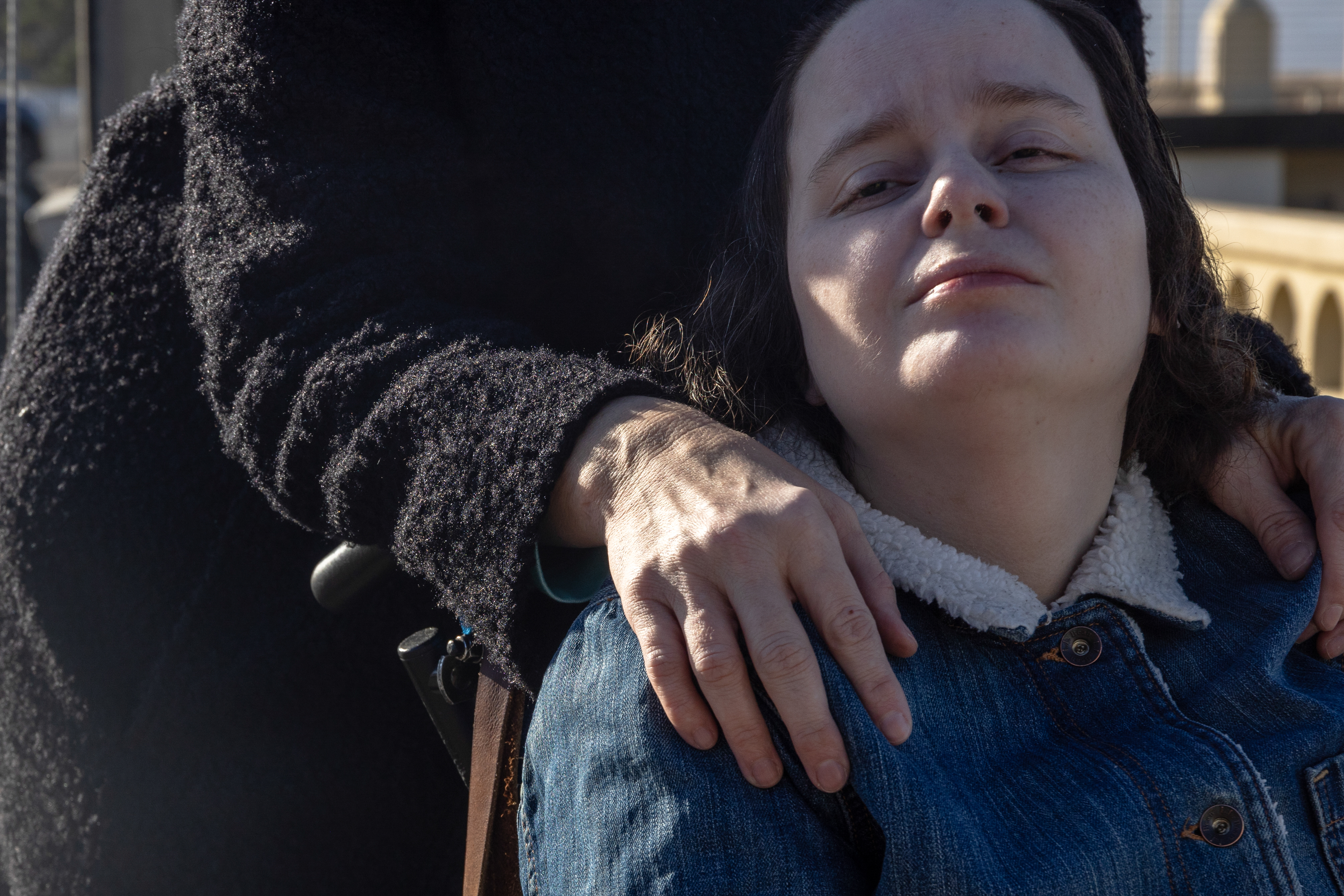
April Foster rests her hands on the shoulders of her daughter, Eilish Foster, on a sunny day in Seaside. (Lukas Prinos/The Astorian)

Mother and daughter April and Eilish Foster enjoy the morning sun. (Lukas Prinos/The Astorian)
The mats aren’t just for wheelchairs, though. Joshua Heineman, Seaside’s director of tourism marketing, said he often sees families with strollers and wagons, visitors with canes and other beachgoers use them, too.
“It’s been surprising how much it’s used actually,” Heineman said. “I mean, even I am somebody who likes walking in the sand, but there’s just something about when you see that road laid out in front of you. You just gravitate towards it.”
Seaside and other cities along the coast also offer free beach wheelchair and track chair rentals. Meanwhile, the Oregon Coast Visitors Association has created a Mobi-mat toolkit to help provide jurisdictions with practical resources for creating a project plan, securing funding and permits and implementing a Mobi-mat program.
Of course, for as many feet of mats extend along the beach, miles of shoreline elsewhere remain inaccessible. Many cities only keep their mats out during the summer months, and those that keep them out for longer can face challenges during events like the king tides. Sayre worries the mats could create an obstacle for vehicles on the beach.
Still, they offer one experience that otherwise might be out of reach — and for Foster, that’s no small thing.
“Obviously there’s limitations, but to have an opportunity to experience it, I think, is pretty special,” she said.
Centering community voices
Efforts to increase accessibility extend beyond the coast’s beaches. At Westport County Park, an ADA-compliant boat ramp and kayak launch recently won Clatsop County a national award from the States Organization for Boating Access. At state parks like Cape Lookout and Nehalem Bay, accessibility improvements are underway thanks to the support of a general obligation bond.
But without the input of people with lived experience, those types of efforts can miss the mark.
“That advocacy is really important,” Sayre said, “and if you don’t have a seat at the table, it’s much harder to make the change.”
That isn’t lost on groups like the Oregon Coast Visitors Association and the Oregon Parks and Recreation Department. Helena Kesch, the department’s ADA and tribal relations coordinator, said working with people from the disability community has played an essential role in informing work like the agency’s accessibility design standards.
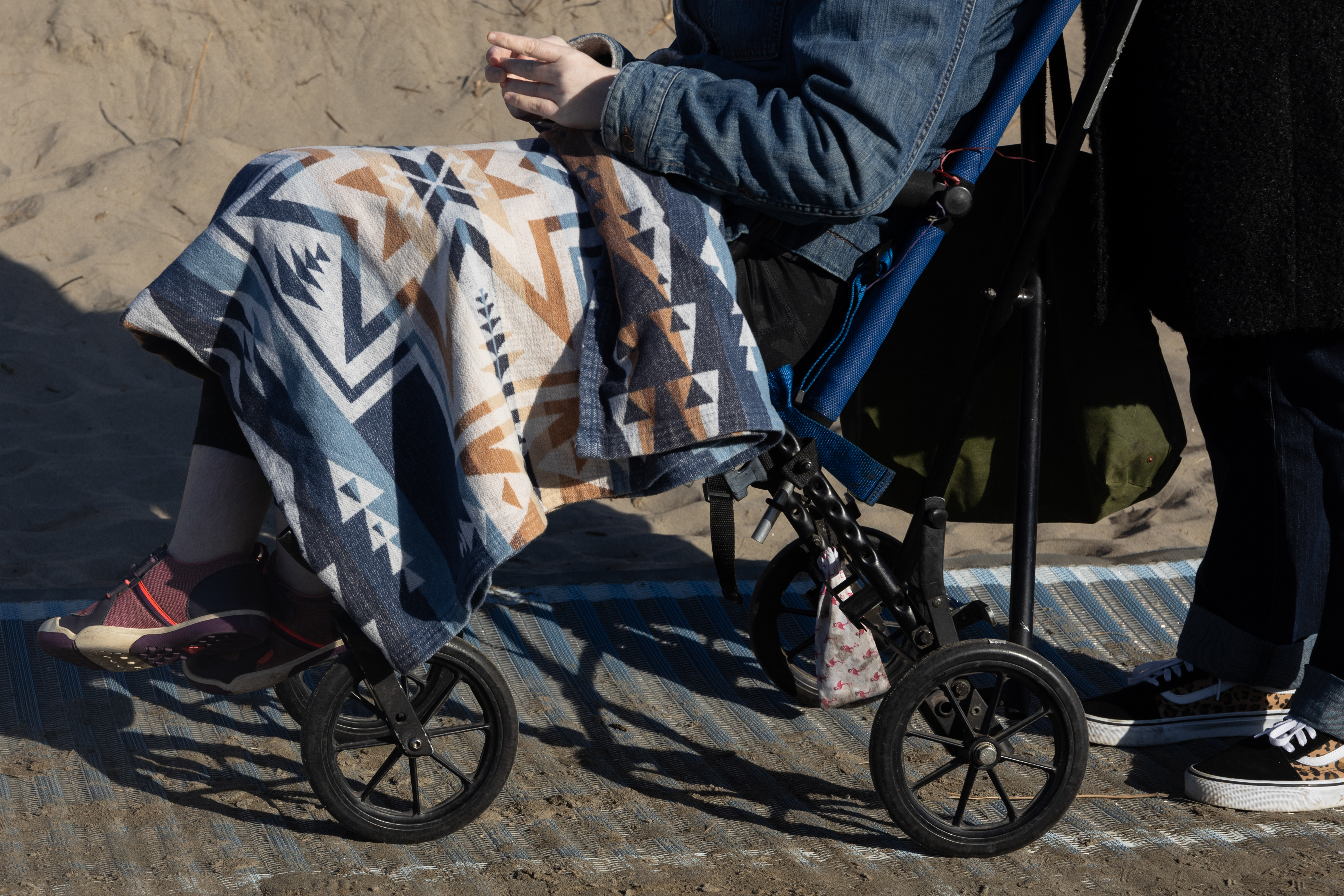
Eilish Foster uses a Mobi-mat to get out onto the beach. (Lukas Prinos/The Astorian)
“Sometimes, if you’re not working with people with lived experience, you don’t know and you’re making assumptions,” Kesch said. “So it’s really important to engage with people with lived experience in the project design and planning phase, even at conception, because there’s things that you just don’t think about when you’re not a person with a disability.”
The Oregon Parks and Recreation Department’s new standards aren’t all-encompassing, though. Rather, they’re a starting point to continue to add to and improve upon. The reality is, increasing accessibility is less of a box to check off and more of an ongoing process of listening, noticing and taking action.
More than anything, Sayre wants to see more people with disabilities communicating their needs to their local jurisdictions — and not just informing accessibility work, but leading it.
“I think that you have to have that population representing themselves and not somebody else representing for you, because while they might be really well-informed, they’re not living the life,” Sayre said. “I’m getting older, and I’m not going to be doing this for much longer, and I had hoped that there would be, you know, 10 people that could take my place, or 20 people that could take my place.”
That kind of involvement, he added, allows for a proactive approach to problem-solving — and a more accessible coast for all.




